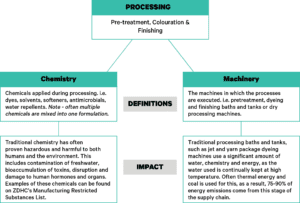Textile Processing Guide: Pretreatment, Colouration and Finishing
An Overview of Processing
An Overview of Processing
During the processing stage, the fibres, yarns, fabrics or garments go through multiple steps to achieve the performance and aesthetic properties desired by brands and their consumers. These steps can be broadly categorised into pre-treatment, colouration and finishing treatments and make up most of the impact taking place in Tier 2.

Traditionally pre-treatment, colouration and finishing are referred to as wet processes as they take place in large tanks or baths filled with water that is constantly kept at a high temperature4. Alongside the pre- treatment, colouration and finishing steps, a significant amount of water and chemistry is wasted as the fabrics also have to be washed off to remove excess dyes. Approximately 10-50% of dyes are washed out in this process, ending up in the effluent water5.
Fashion for Good divides the processing stage in two categories to help differentiate between the chemical applied ie: chemistry and the process by which this chemistry is applied ie: machinery. An overview is outlined below in Figure 2.

DW(O)R FINISH AND PFCs
What are Durable Water and Oil Repellency (DW(O)R) and perfluorochemicals (PFCs)?
- DW(O)R finishes ensure fabrics repel water and oil by preventing these liquids from spreading on the fabric surface and wetting the fabric.
- The performance of the repellency can be assessed through a variety of testing methods.
- Traditional DW(O)R finishes contain perfluorochemicals (PFCs) to achieve high performance.
- PFC can refer to two distinct but related chemical classes:
-
The first are chemicals which include toxic perfluorooctanesulfonic acid (PFOS) and other per- and polyfluoroalkyl substances (PFOAs).
-
PFOSs have been linked to kidney and testicular cancer, as well having a negative impact on human thyroid function
-
PFOAs are reprotoxic; decreasing fertility and having adverse developmental effects
-
- The second refers to perfluorocarbons, which share similar characteristics but only contain fluorine and carbon atoms. They are difficult if not impossible to break down and are therefore also referred to as forever chemicals.
-
- As a result, a significant effort is going into finding high performing PFC-free DW(O)R treatments, Fashion for Good is supporting innovators, such as OSM Shield ZERO and Dryfiber, focusing on this.
Source: EPA (2019), Sepa (2019), Nicole (2013), O’Rourke & Strand (2017)
ANTIMICROBIAL FINISH AND HEAVY METALS
What are antimicrobial finishes and heavy metals?
- Antimicrobial finishes are applied to inhibit the growth of bacteria, mould and fungi on fabrics. Thiskeeps the fabrics hygienic and prevents odours. Antibacterial finishes are a kind of antimicrobial finish that can kill or inhibit the growth of bacteria such as E.coli. These finishes will not be effective against viruses (e.g. coronavirus)6.
- Antiviral finishes claim to kill or inhibit viruses, typically in addition to being antimicrobial7.
- Many antimicrobial and viral finishes have been proven to contain heavy metals such as silver, copper and zinc8. These can leach into water and impact aquatic life. Besides this, studies have shown they can be harmful to humans when ingested or exposed to skin. In fact, the extent of the effects of heavymetals on humans is still unknown9.
- Bio-based and/or heavy metal free antimicrobial finishes are being developed. Fashion for Good issupporting multiple innovators, such as Nordshield and OSM V-Shield, who focus on this.
A number of solutions exist that would help reduce the use of water, energy and harmful chemistry in this stage of the supply chain. Some of these are incremental solutions whilst others are disruptive innovations. The next section briefly touches on some of these incremental solutions, you can learn more about these solutions in Fashion for Good x Apparel Impact Institute (Aii)’s report ‘Unlocking the Trillion – Dollar Fashion Decarbonisation Industry’. The report charts a trajectory for the industry to meet its net- zero ambition, breaking down the funding needed and mapping the integral levers across existing and innovative solutions.
